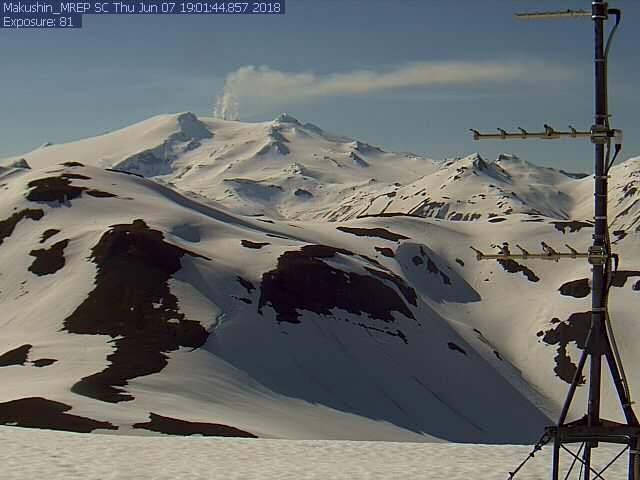
Active fumaroles at the summit of Makushin volcano.
Volcano(es): Makushin
Photographer: Schaefer, Janet
URL: avo.alaska.edu/image/view/116941
Makushin unrest 2018
From Cameron and others, 2023: "Makushin Volcano continued showing signs of unrest in 2018. After the eruption of nearby Bogoslof volcano in 2016-2017, reports of steaming from the summit of Makushin Volcano increased in frequency. The number of located earthquakes near Makushin Volcano has also increased since 2012. Despite these mild signs of unrest, no observations were enough to raise the Aviation Color Code or Volcano Alert Level, which remained at GREEN and NORMAL throughout the year.
"Steam emissions from Makushin Volcano were noted multiple times in the summer of 2018, both through webcam images seen by observatory personnel and in reports sent to AVO by residents of the City of Unalaska, Alaska. None of these reports differ in content from previous reports archived at AVO, which go back more than a decade. The increase in reports may be due in part to the activity at Bogoslof volcano, which could have prompted residents to forward more observations to AVO.
"Independent of the increased frequency of reports of steaming, AVO performed its first aerial summit gas survey at Makushin Volcano in the summer of 2018. Gas observations from the volcano’s gas plume yielded SO2 fluxes of ~100 t/d along with low CO2/Stotal (~1.5/2.5) and SO2/H2 S ratios (~1.1/1.7). These observations are consistent with degassing from a hot, mixed magmatic-hydrothermal system. The presence of SO2, a magmatic gas, has not previously been detected from ground-based measurements at Makushin Volcano, although it was also detected at the volcano by a new instrument, the TROPOspheric Monitoring Instrument on the Copernicus Sentinel-5 Precursor satellite, which launched in the fall of 2017. Until repeat surveys establish baseline data, however, the significance of this SO2 is unknown.
"The increase in seismicity that began in 2012 continued in 2018, with more than 1,000 earthquakes located by AVO near Makushin Volcano during the year. As is typical for Makushin Volcano seismicity, several short earthquake swarms were noted. Four of these clusters, which took place in the months of January, July, September, and November, were located 5-10 km [3.1-6.2 mi] southeast of the summit, making this area the most seismically active on the volcano. Three more swarms took place in January, March, and June, about 20 km [12.5 mi] to the northeast, southwest, and southeast of the summit, respectively."
Please cite the photographer and the Alaska Volcano Observatory / U.S. Geological Survey when using this image.
Full Resolution.